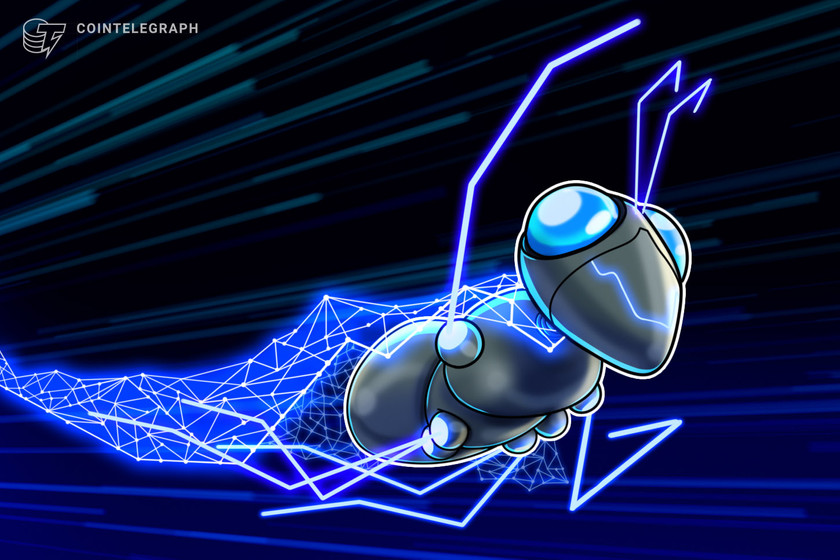Polkadot: How parachains are changing a blockchain-centric ecosystem


Parity chief marketing officer Peter Ruchatz discusses the ins and outs of Polkadot’s focus on interoperability at Token2049.
Smart contract blockchains have played a pivotal role in creating wide-ranging functionality after the advent of Bitcoin in 2009. Ethereum led the way in this regard, but innovative technology stacks like Polkadot have brought a new paradigm to the sector.
It’s been just less than a year since Polkadot’s Relay Chain went live in December 2021, and the platform’s ecosystem continues to grow as interest in Web3 increases across the world. Polkadot shares an intrinsic link to Ethereum given that its creator Gavin Wood played a role as a co-founder of the preeminent smart contract platform some seven years ago.
Cointelegraph explored the burgeoning Polkadot ecosystem in a wide-ranging conversation with Parity Technologies chief marketing officer Peter Ruchatz during the Token2049 conference in Singapore in September 2022. From inception to its growing use cases, the parachain-pioneering Polkadot ecosystem suggests that blockchain technology will continue to evolve through interoperable systems.


As a starting point, Ruchatz agreed that Polkadot and its older proof-of-stake (PoS) siblings Ethereum and Cardano are in a state of harmony, co-existing despite providing similar blockchain-based use cases to decentralized applications (DApps) and projects running on their infrastructure.
Ruchatz highlighted the disruptive nature of the fundamentally new technology that influences various industries, drawing parallels to how Amazon Web Services powers Netflix while the end-user is oblivious to the underlying cloud technology:
“I think we are again at an inflection point and at that early stage in a technology shift, you have many experiments, many emerging platforms and approaches and the shakeout will happen over time. Sometimes you continue having five leading, maybe three leading or hopefully just one leading platform and it gives options and choices.”
There are fundamental differences between the concepts, opportunities and value propositions of Ethereum, Cardano and Polkadot, and Ruchatz believes a major hurdle is articulating and educating people on why each project is useful. In the case of Polkadot, the potential use cases and needs of its parachain functionality are important to consider.
Recent: Demand for talent in crypto less dependent on market as industry matures
Polkadot’s Relay Chain is a major attraction to potential users, according to Ruchatz, with the base layer providing a means to create custom blockchains with their own tokenomics or business parameters to suit specific needs.
This is a draw card that he believes differentiates the platform from other general-purpose, “one size fits all” blockchain protocols like Ethereum, Avalanche, Cardano and Solana, which Ruchatz suggested cater more toward building DApps and smart contract functions and services:
“If you truly want to innovate and explore a completely new industry or use case and have the appetite to build something revolutionary, something new and build for the long term, you cannot not build your own blockchain.”
Compounding effects
Polkadot’s signature parachains are separate blockchains that run in parallel while achieving consensus and security through the network’s base Relay Chain. This differs from other smart contract blockchains like Ethereum and Cardano, which need to facilitate all transactions, smart contract and DApp activity on a single chain or through layer solutions.
As Ruchatz explained to Cointelegraph in Singapore, Polkadot provides the foundation, security mechanisms, validations and consensus through the Relay Chain. Developers make use of the ecosystem’s software development kit (SDK) Substrate to develop proprietary blockchains that are able to work in tandem with the wider ecosystem.
Parachains benefit from each other by importing functionality from other parachains that have been built, allowing the use of code from other parachains on a blockchain level:
“Another thing which we now see happening with so many parachains live is a compounding effect, a synergistic effect, because of Polkadot’s architecture with interoperability and upgradability. We’ve upgraded the runtime already many, many times. I think no other system can do it.”
This collaborative ecosystem is a key driver of new users, according to the Parity chief marketing officer, with use cases emerging that have the potential to disrupt centralized products and services currently being used by the wider public around the world:
“A good example is the KILT protocol which is building an authentication service disrupting DocuSign. That alone is a big use case however the edification is something that other parachains don’t need to rebuild anymore.”
Ruchatz also highlighted innovations like NFT 2.0, programmable nonfungible tokens (NFTs) that pull cross-chain composable architecture from multiple chains, as well as blockchain-based music marketplaces competing with the likes of “Napsters or Spotify.” The team at Merklebot has even built a Polkadot-connected DApp to connect and control Boston Dynamics’ Spot mobile robots.
Interoperability and Ethereum
Ethereum’s highly-anticipated move from proof-of-work (PoW) to PoS consensus finally came to fruition in September 2022. With interoperability part of Polkadot’s DNA, Ruchatz said that connecting to Ethereum in certain ways was being looked into by some ecosystem participants:
“We are excited to see Ethereum finally join the proof-of-stake club. They still have a long way to go and have solved just one of their challenges. Nevertheless, this opens up collaboration and interoperability and we have some parachains teams that are exploring that already. We don’t want to be a closed shop.”
Part of the focus on interoperability and parachain functionality is part of a broader philosophical goal of the Polkadot ecosystem to become what Ruchatz described as “unstoppable.” A clear commitment to decentralization and transparency in governance structure has been central to Wood’s goal for Polkadot to achieve “coded democracy,” as Ruchatz explained:
“It goes as far as saying that Parity and the Web3 Foundation should be redundant at one point and become obsolete. We want the community to carry Polkadot forward and make it something that cannot be stopped by any government or central institution because it is truly decentralized.”
Recent: After Ethereum Merge, GPU prices may stabilize with dipping demand
Polkadot had a strong presence at Token2049 in Singapore, with a large staging area showcasing different parachain projects that are building in the ecosystem. The Asia-Pacific region is also home to a number of parachain development teams, with a healthy community acting as ambassadors for the ecosystem.
This was evident at the Polkadot exhibit, as the different parachains teams present had a chance to mingle and share thoughts and ideas with other projects that are interwoven into the parachain-powered ecosystem.






